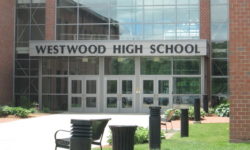[ccfic caption-text format="plaintext"]
By Robert Rosen
Hometown Weekly Staff
With one of the largest conversations around Wellesley currently focused around the future of the Hardy, Hunnewell and Upham Schools, the School Committee and Superintendent Dr. David Lussier believe a lot of data was collected over time and that the best option is to ultimately close Hardy, renovate Hunnewell and build a new Upham, a process that in total will likely take 6-9 years.
“There’s a bit of a perception out there that we want to build a new school and close a school early in the game,” said School Committee Chairperson Matt Kelley. “We studied for a few years.”
“The largest thing is the quality of learning,” added Lussier. “We have many more needs of smaller collaborative spaces. These schools just don’t have the spaces.”
Lussier is in his fourth year in Wellesley and noted that when he arrived in town there were different tiers of buildings, with the new high school obviously the crown jewel of the district. He said that Sprague and Bates are in excellent shape, and Fiske and Schofield are right below them and need some work. The middle school is in similar shape to Fiske and Schofield, but then Hardy, Hunnewell and Upham need either complete replacement or major renovations.
In 2012 Wellesley Public Schools contracted with an expert company named Cropper to do an enrollment study of the school district. The results, which were received in 2013, showed that the elementary school population in Wellesley is declining.
In 2008-09, there were just under 2,500 students in Wellesley elementary schools, and that number has dropped to just under 2,300. Cropper suggested that those number could decline to under 2,000 in 2023-24.
“That in itself is interesting but probably wouldn’t drive us into action if we didn’t have these building problems,” Kelley said. “It’s not that you see enrollment declining so you say close a school, but you have to take it into account.”
Many people in town, particularly parents, have asked why the schools couldn’t all just be renovated. For one, the wisdom in this area suggests that when a school is renovated it will last an additional 25 years, while a new building will last 50 years. Kelley also pointed out that you can’t change the footprint of the school with a renovation.
In addition, there is a tremendous savings under the current recommended HHU plan over full renovations for all three schools. The current recommendation would cost $96 million, while keeping all three schools open with renovations could cost one of three separate numbers: $116 million, $126 million or $140 million.
The district could also save an additional $500,000 per year by reducing a principal, secretary and a couple of other positions, as well as operating costs such as heat.
The School Committee and Lussier also feel that this proposal will also strengthen neighborhood schools. Currently 34 percent of elementary school students in the district live within a half mile of their school, while 77 percent live within a mile.
But despite being fairly close to school, many students are hindered by boundaries like Route 9 and Washington St. Approximately half of Hardy students live north of Route 9, for example, making it difficult for those students to walk or bike to school. Under the new proposal, the 34 percent drops to 29 percent, but there will be less natural boundaries for students and parents to worry about.
“We think those natural boundaries actually hinder kids walking to school,” Lussier said. “People get pretty leery about kids crossing Route 9 or Washington St. We think rather than fighting those boundaries and embracing them we think it would strengthen neighborhood schools.”
Lussier pointed out that the elementary schools were re-districted in 2002 when Sprague re-opened and compared the current re-districting plan to what was in place from 1982-2002.
“People adapt to the schools they’re in,” Lussier said. “We don’t have a single bad school. We think the walking distance doesn’t change. In fact, we might have more walking.”
The Parent Advisory Committee will meet on Thursday, January 21 and is expected to make a counterproposal. The School Committee will then deliberate on the issue publicly before the next phase, which would be a request for funds for a feasibility study at the annual Town Meeting.
“We all acknowledge it’s an emotional issue,” Lussier said. “It’s an emotional issue for our community… I think at some level we need to be dispassionate in trying to think about the needs of the school district, the needs of our kids and the needs of the entire community both in terms of educational environment and the resources that we’re committing not for the short term but for the long term.
“I’m not sure the community would want us to make an emotional decision even though I think we have to acknowledge there’s a great deal of emotion.”
Kelley pointed out that it’s not ultimately the School Committee’s decision; rather, it will go to Town Meeting and then a town wide vote.
“We have done our analysis and made our recommendation,” Kelley said. “If the town votes otherwise than the town will have spoken.”
Robert Rosen can be contacted at news@hometownweekly.net or followed on Twitter @roberterosen.























